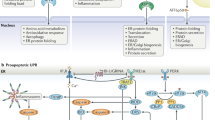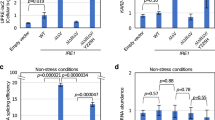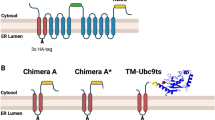Abstract
Ubiquitin conjugation during endoplasmic-reticulum-associated degradation (ERAD) depends on the activity of Ubc7. Here we show that Ubc1 acts as a further ubiquitin-conjugating enzyme in this pathway. Absence of both enzymes results in marked stabilization of an ERAD substrate and induction of the unfolded-protein response (UPR). Furthermore, basic ERAD activity is sufficient to eliminate unfolded proteins under normal conditions. However, when stress is applied, the UPR is required to increase ERAD activity. We thus demonstrate, for the first time, a regulatory loop between ERAD and the UPR, which is essential for normal growth of yeast cells.
This is a preview of subscription content, access via your institution
Access options
Subscribe to this journal
Receive 12 print issues and online access
$209.00 per year
only $17.42 per issue
Buy this article
- Purchase on Springer Link
- Instant access to full article PDF
Prices may be subject to local taxes which are calculated during checkout







Similar content being viewed by others
References
Sommer, T. & Wolf, D. H. Endoplasmic reticulum degradation: reverse protein flow of no return. FASEB J. 11, 1227–1233 (1997).
Kopito, R. R. ER quality control: the cytoplasmic connection. Cell 88, 427–430 (1997).
Bonifacino, J. S. & Weissman, A. M. Ubiquitin and the control of protein fate in the secretory and endocytic pathways. Annu. Rev. Cell Dev. Biol. 14, 19– 57 (1998).
Plemper, R. K. & Wolf, D. H. Retrograde protein translocation: ERADication of secretory proteins in health and disease. Trends Biochem. Sci. 24, 266–270 (1999).
McCracken, A. A. & Brodsky, J. L. Assembly of ER-associated protein degradation in vitro: dependence on cytosol, calnexin, and ATP. J. Cell Biol. 132, 291–298 (1996).
Plemper, R. K., Bohmler, S., Bordallo, J., Sommer, T. & Wolf, D. H. Mutant analysis links the translocon and BiP to retrograde protein transport for ER degradation. Nature 388, 891–895 ( 1997).
Jakob, C. A., Burda, P., Roth, J. & Aebi, M. Degradation of misfolded endoplasmic reticulum glycoproteins in Saccharomyces cerevisiae is determined by a specific oligosaccharide structure. J. Cell Biol. 142, 1223–1233 (1998).
Wiertz, E. J. et al.. Sec61-mediated transfer of a membrane protein from the endoplasmic reticulum to the proteasome for destruction. Nature 384, 432–438 (1996).
Zhou, M. Y. & Schekman, R. The engagement of Sec61p in the ER dislocation process. Mol. Cell 4, 925 –934 (1999).
Hampton, R. Y., Gardner, R. G. & Rine, J. Role of 26S proteasome and HRD genes in the degradation of 3-hydroxy-3-methylglutaryl-CoA reductase, an integral endoplasmic reticulum membrane protein. Mol. Biol. Cell 7, 2029 –2044 (1996).
Knop, M., Finger, A., Braun, T., Hellmuth, K. & Wolf, D. H. Der1, a novel protein specifically required for endoplasmic reticulum degradation in yeast. EMBO J. 15, 753–763 (1996).
Bordallo, J., Plemper, R. K., Finger, A. & Wolf, D. H. Der3p/Hrd1p is required for endoplasmic reticulum-associated degradation of misfolded lumenal and integral membrane proteins. Mol. Biol. Cell 9, 209–222 ( 1998).
Deshaies, R. J. SCF and cullin/RING H2-based ubiquitin ligases. Annu. Rev. Cell Dev. Biol. 15, 435–467 ( 1999).
Biederer, T., Volkwein, C. & Sommer, T. Degradation of subunits of the Sec61p complex, an integral component of the ER membrane, by the ubiquitin-proteasome pathway. EMBO J. 15, 2069–2076 ( 1996).
Hiller, M. M., Finger, A., Schweiger, M. & Wolf, D. H. ER degradation of a misfolded luminal protein by the cytosolic ubiquitin-proteasome pathway. Science 273, 1725– 1728 (1996).
Hampton, R. Y. & Bhakta, H. Ubiquitin-mediated regulation of 3-hydroxy-3-methylglutaryl-CoA reductase. Proc. Natl Acad. Sci. USA 94, 12944–12948 (1997).
Biederer, T., Volkwein, C. & Sommer, T. Role of Cue1p in ubiquitination and degradation at the ER surface. Science 278, 1806– 1808 (1997).
Chapman, R., Sidrauski, C. & Walter, P. Intracellular signaling from the endoplasmic reticulum to the nucleus. Annu. Rev. Cell Dev. Biol. 14, 459–485 (1998).
Cox, J. S. & Walter, P. A novel mechanism for regulating activity of a transcription factor that controls the unfolded protein response . Cell 87, 391–404 (1996).
Tirasophon, W., Welihinda, A. A. & Kaufman, R. J. A stress response pathway from the endoplasmic reticulum to the nucleus requires a novel bifunctional protein kinase/endoribonuclease (Ire1p) in mammalian cells. Genes Dev. 12, 1812–1824 (1998).
Sidrauski, C. & Walter, P. The transmembrane kinase Ire1p is a site-specific endonuclease that initiates mRNA splicing in the unfolded protein response. Cell 90, 1031– 1039 (1997).
Kawahara, T., Yanagi, H., Yura, T. & Mori, K. Endoplasmic reticulum stress-induced mRNA splicing permits synthesis of transcription factor Hac1p/Ern4p that activates the unfolded protein response. Mol. Biol. Cell 8, 1845–1862 (1997).
Seufert, W., McGrath, J. P. & Jentsch, S. UBC1 encodes a novel member of an essential subfamily of yeast ubiquitin-conjugating enzymes involved in protein degradation. EMBO J. 9, 4535–4541 ( 1990).
Sommer, T. & Jentsch, S. A protein translocation defect linked to ubiquitin conjugation at the endoplasmic reticulum. Nature 365, 176–179 (1993).
Jungmann, J., Reins, H-A., Schobert, C. & Jentsch, S. Resistance to cadmium mediated by ubiquitin-dependent proteolysis. Nature 361, 369–371 (1993).
Kaufman, R. J. Stress signaling from the lumen of the endoplasmic reticulum: coordination of gene transcriptional and translational controls. Genes Dev. 13, 1211–1233 ( 1999).
Seufert, W. & Jentsch, S. Ubiquitin-conjugating enzymes UBC4 and UBC5 mediate selective degradation of short-lived and abnormal proteins . EMBO J. 9, 543–550 (1990).
Bush, K. T., Goldberg, A. L. & Nigam, S. K. Proteasome inhibition leads to a heat-shock response, induction of endoplasmatic reticulum chaperones, and thermotolerance. J. Biol. Chem. 272, 9086–9092 (1997).
Ausubel, F. M. et al. Current Protocols in Molecular Biology (John Wiley and Sons, New York, 1989).
Mori, K. et al. A 22 bp cis-acting element is necessary and sufficient for the induction of the yeast KAR2 (BiP) gene by unfolded proteins. EMBO J. 11, 2583–2593 ( 1992).
Acknowledgements
We thank D. Wolf for the pRS306prc1–1 plasmid and the UPR– lacZ reporter construct, and K. Stade and members of the Sommer laboratory for helpful discussions and critical reading of the manuscript. This work was partially supported by grants from the Deutsche Forschungsgemeinschaft and the Deutsch-Israelische Projektkooperation (DIP) to T. S. E. J. was the recipient of fellowships from the Austrian Fonds zur Förderung der Wissenschaftlichen Forschungs and the Marie Curie TMR programme of the European Community.
Correspondence and request for materials should be addressed to T. S.
Author information
Authors and Affiliations
Corresponding author
Rights and permissions
About this article
Cite this article
Friedlander, R., Jarosch, E., Urban, J. et al. A regulatory link between ER-associated protein degradation and the unfolded-protein response.. Nat Cell Biol 2, 379–384 (2000). https://doi.org/10.1038/35017001
Received:
Revised:
Accepted:
Published:
Issue Date:
DOI: https://doi.org/10.1038/35017001
This article is cited by
-
Mechanisms of substrate processing during ER-associated protein degradation
Nature Reviews Molecular Cell Biology (2023)
-
Endoplasmic reticulum stress-responsive microRNAs are involved in the regulation of abiotic stresses in wheat
Plant Cell Reports (2023)
-
Improved pinene production in a recombinant yeast by fusion linker optimization and chaperon coexpression
Systems Microbiology and Biomanufacturing (2022)
-
A positive genetic selection for transmembrane domain mutations in HRD1 underscores the importance of Hrd1 complex integrity during ERAD
Current Genetics (2022)
-
Characterization and modulation of endoplasmic reticulum stress response target genes in Kluyveromyces marxianus to improve secretory expressions of heterologous proteins
Biotechnology for Biofuels (2021)



